An authentic replica of a winning 1970 Porsche 914/6 GT
In 1970, the 914/6 GT enjoyed a brief moment in the sun, taking the first three places at the Nürburgring’s 86-hour Marathon de la Route. We sample a staggeringly authentic replica of the no.1 car...
Words Johnny Tipler
Photography Dan Sherwood
TALES OF GLORY
Ideally, if you’re going to base a replica on a specific race car, you want it to have been a really successful one. And when it comes to the competition history of the 914/6, it didn’t get any better than a one-two-three at the 1970 Marathon de la Route. How so? Well, consider racing for an unbroken eighty-six hours around the Nürburgring. That’s what the Marathon consisted of — three-and- a-half day’s racing, effectively. And to bag the first three places means pretty much everything went according to plan.
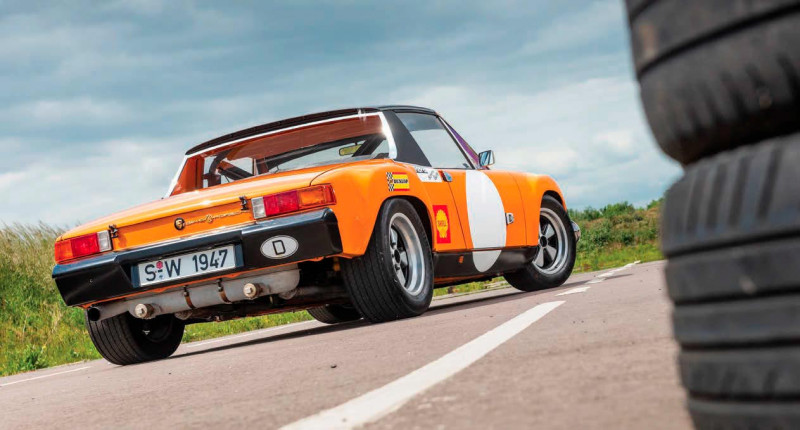
Held from 4th to 7th August, 1970, the Marathon de la Route replaced the Spa-Sofia-Liege rally and attracted a field of sixty-four international touring cars (like the 911, the 914 was briefly classified as a touring car). Just twenty-four entrants were classified finishers. After all, you don’t do three and a half days around the 17.5-mile combined Nordschleife and Sudschleife and get away lightly.
THIS 914 MORE THAN QUALIFIES FOR ITS HISTORIC TECHNICAL PASSPORT, USED TO CHECK THE CONFORMITY OF A CLASSIC COMPETITION CAR
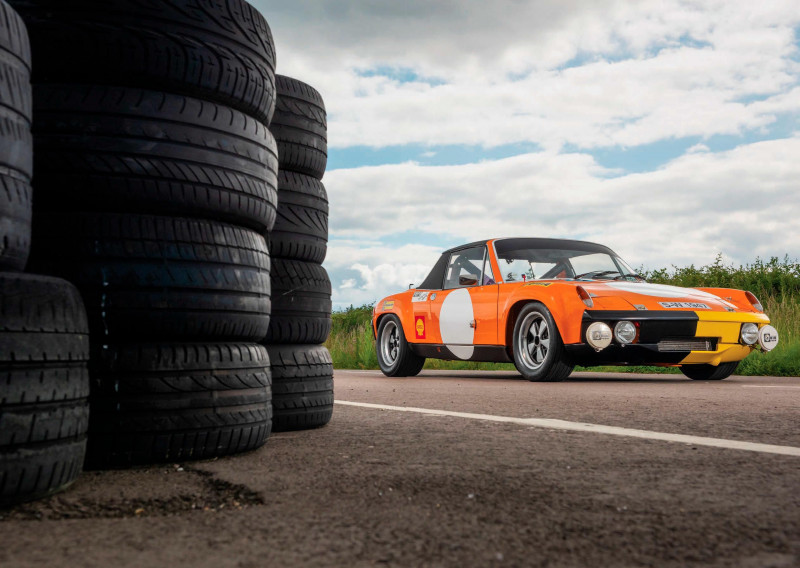
The race’s early leaders, Roy Pierpoint, Roger Enever and Clive Baker — the trio were sharing driving duties in a 4.3-litre Rover V8 — pulled out a six-lap lead and stayed in front for sixteen hours before being sidelined with an out-of-balance propshaft. A succession of privateer 911s then took the lead, with the trio of works 914/6s having a slow-burn run through the pack to occupy the first three places. Winners were Gérard Larrousse, Claude Haldi and Helmut Marko, credited with 358 laps. Coming up in second place were Bjorn Waldegård, Åke Andersson and Guy Chasseuil on 357 laps. Rounding out the podium were Claude Ballot-Lena, Günther Stekkonig and Nicolas Koob with 354 laps completed. All these guys were prominent Porsche works or semiworks drivers. The rest of the entry list comprised an array of what were then state-of-the-art machines from Alfa Romeo, BMW, NSU, Renault and Opel, largely helmed by privateers and joined by various Mini-Cooper Ss, including a works entry.
PORSCHE WISHED TO EVALUATE THE ROADSTER ON THE ROUGH STUFF AS A POSSIBLE SUCCESSOR TO THE RALLY-SPECIFICATION 911
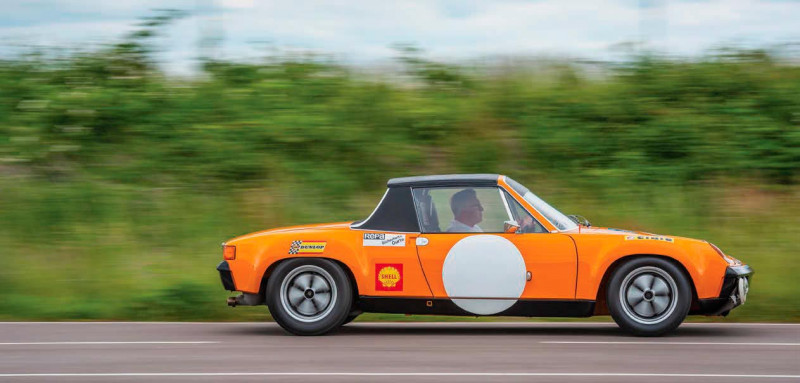
What we have here is a perfect replica of one of those three Marathon-winning 914/6 GTs. Currently gracing the showroom at Bedfordshire-based air-cooled Porsche sales specialist, Export 56, the car was built in the USA by Mark Allin, head of Ferrari, Porsche and Mercedes-Benz restoration outfit, Rare Drive, located in East Kingston, New Hampshire. In case you were wondering, the zesty air-cooled Porsche is based on a genuine matching-numbers 914/6. To get us up to speed, here’s a bit of history. The 914 came into being as a joint venture between Porsche and Volkswagen. The latter wanted a substitute for the sleek Karmann Ghia sportster models, while Porsche sought an alternative entry-level offering to the 912, in production since 1965, but being readied for discontinuation. With a 1,679cc fuel-injected flat-four engine sourced from the VW 411 E and mounted amidships, the 914 took buyers into the domain of competition cars. And, with a Targa top and integral rollover hoop, the boxy twoseater could swiftly convert from coupé to a fresh-air roadster. For the 914/6, Porsche installed the Type 901 two-litre flat-six from the same-age 911 T.
BREAK GROUND
The prototype 914/4 and 914/6 were shown at the Frankfurt Motor Show in March 1968, but the scheme almost fell apart when the Wolfsburg concern backed away from the project — VW’s incoming CEO, Kurt Lotz, reneged on the earlier verbal agreement stipulating Porsche would take care of the 914’s design and development and VW would pick up the tab. He felt this was a less than attractive proposition for VW, despite the respective sizes and complementary abilities of the two firms. Moreover, he felt VW had full and exclusive rights to the 914 if Porsche was unwilling to share in tooling and development costs. As a consequence of this production standoff, manufacturing costs rocketed, making the 914/6 only marginally cheaper than the 911 T. The 914 was marketed as a VWPorsche in Europe and as a Porsche in all US states except California, where it was sold exclusively by Volkswagen dealers.

The model was a roaring success, shifting close to 119,000 units, outselling the 911 by a significant margin. Even so, slow sales for the robustly priced 914/6 saw Porsche discontinue the six-cylinder model in 1972.
During the 914/6’s time in production (totalling 3,351 examples assembled), Porsche offered the 914/6 with the M471 racing option, assembled on the Porsche and Bauer lines in Stuttgart, with the exception of specific competition components. Additionally, between 1969 and 1970, Porsche’s Weissach development centre built twelve 914/6 GTs for use by the factory competition department. Three were prototype test cars, while the three already mentioned were entered into the 1970 Marathon de la Route. The same trio served as 1970 Targa Florio practice cars and one participated in the 1970 RAC Rally. Three more competed in the 1971 Monte-Carlo Rally. In all, forty-seven examples of the customer-racing 914/6 GT were sold. The factory also offered a separate GT kit, which could be ordered when buying a standard 914/6.
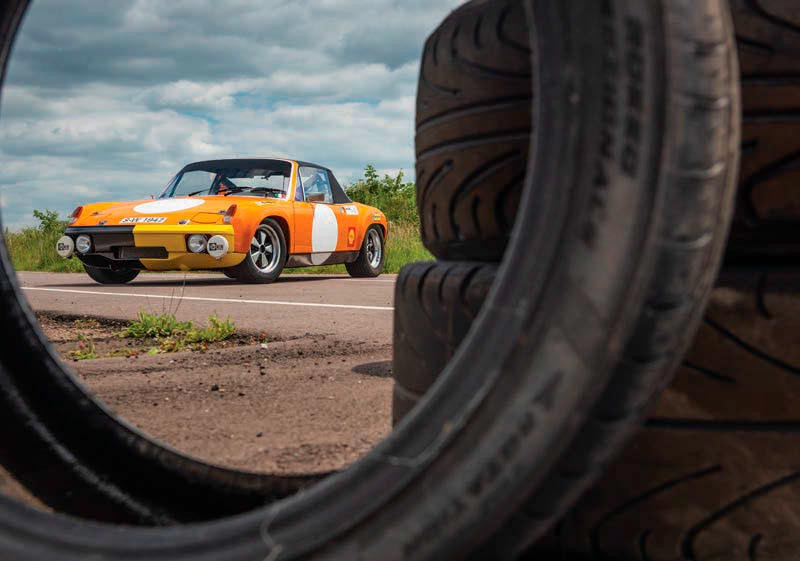
The extra parts were installed by designated Porsche dealers, though it’s unknown how many kits were actually invoiced. While the 914 was on sale, buyers hardly flocked to Porsche’s European showrooms, though the model sold well enough in the USA — during six years in production from 1969, sales of four-cylinder 914s totalled 115,646, of which close to 104,000 were sold in North America. This was a busy time for Karmann, which not only made 911 bodies, but was contracted to assemble the Karmann Ghia and the 914’s shell. The 914/6, meanwhile, was assembled at Zuffenhausen and Weissach under the stewardship of Ferdinand Piëch, who headed up Porsche’s motorsport division at the time.
Despite the 914/6 GTS of Chasseuil and Claude Ballot-Lena placing sixth overall and winning their class at Le Mans in 1970 (you may have spotted the car sneaking into shot during Steve McQueen’s movie, Le Mans, filmed during the race), the 914/6 didn’t enjoy an especially long or distinguished race career. Used as a reconnaissance car by works drivers, including Vic Elford, Brian Redman and Jo Siffert, for the Targa Florio, the unusual Porsche wasn’t much loved because these drivers couldn’t hang the tail out. Moreover, Waldegård and Richard Attwood actively disliked the 914/6, voicing their concern the model’s handling was too neutral when compared with that of the 911. But hey, what do these superstars know?
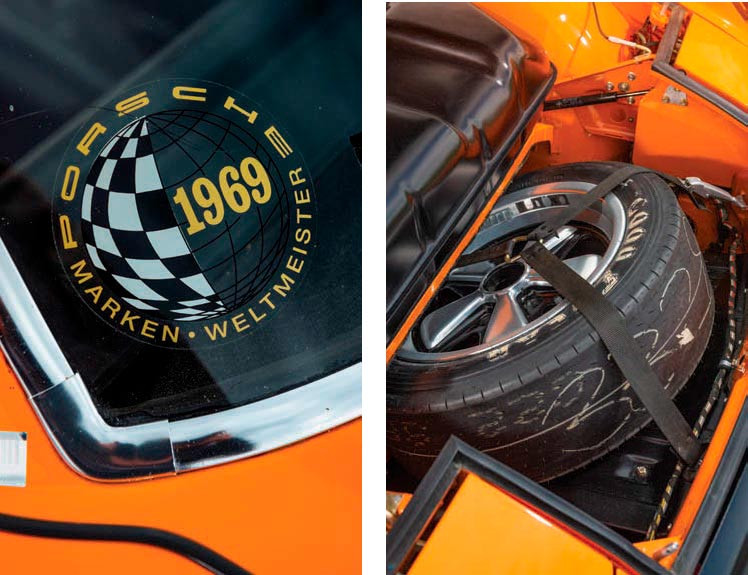
Having campaigned a 914 for two thousand miles in Mexico’s La Carrera Panamericana road race, I can attest to the model’s peerless ability and agility in the event’s winding mountain stages, where it was an untouchable go-kart, aided and abetted by wider wheels and spacers, able to overtake V8-propelled American muscle, though the little Porsche was swallowed up as if standing still on long desert straights.
And what of the other competition forays for the 914/6? The final round of the 1970 European Rally Championship series was the RAC Rally. The works teams went in mob-handed. Porsche was just three points clear of Alpine- Renault, resulting in four entries from Stuttgart: pairings of Waldegård/Lars Helmér, Andersson/Bo Thorszelius and Gérard Larrousse/Mike Wood were sharing the driving across a trio of 911 Ss, while Claude Haldi and John Gretener were driving a 914/6. Porsche wished to evaluate the roadster on the rough stuff as a possible successor to the rally-specification 911. The event extended from Scotland to Wales, taking in eighty forests.
It was on the Scottish stages that the Swedish crews retired with broken differential-gearbox units. Haldi/Gretener’s 914/6 finished twelfth, but Alpine only lost the championship to Porsche on the last stage, when Jean- Luc Thérier’s A110 snapped a driveshaft.
ITALIAN JOB
All three of the 914/6s entered into the following year’s Monte-Carlo Rally (the Waldegård/Thorszelius Porsche finished third) were prepared as training cars for the same season’s Targa Florio. Vic Elford drove one of the trio from Stuttgart to Monza for the venue’s 1,000km race, then on to Sicily, where he drove twenty practice laps of the Targa Florio circuit before returning the car to Zuffenhausen. 914/6 GTs used for the Targa Florio training programme were equipped with then new 2.2-litre ‘T’ flat-sixes.
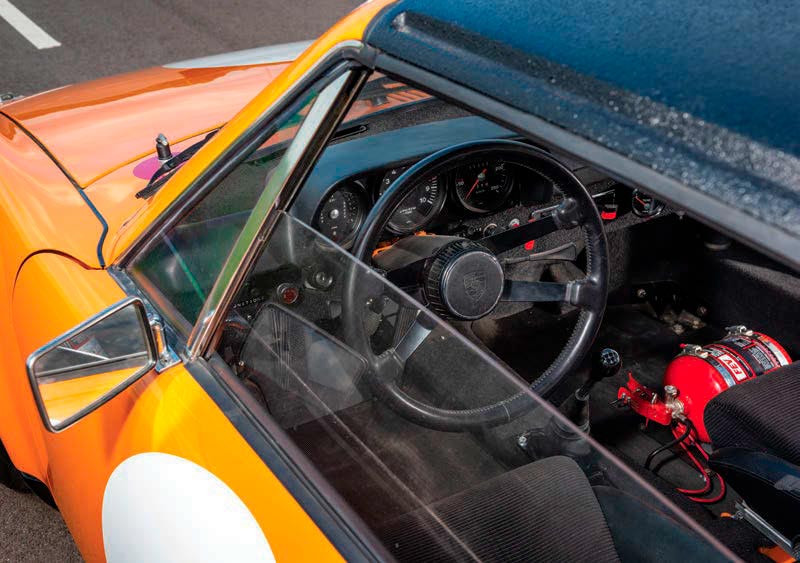
How about our feature car? This 914/6, chassis number 9140432197, is a workshop copy of the 1970 Nürburgring Marathon de la Route works no.1 entry, which no longer exists. The recreation is aesthetically perfect. As mentioned earlier, the car was meticulously built by Mark Allin at Rare Drive, using correct and mostly new-old-stock factory 914/6 GT parts. The car has recently competed in several European events, including the French Tour Auto, finishing second in this year’s Group G1/G2 class, winning six of the eight closed rally stages. Allin has also restored several other original 914/6 GTs, including the Lufthansa privateer car, the 1970 Marathon de la Route factory no.2 entry and 1971’s 24 Hours of Daytona Sunoco-sponsored machine.
The bodywork consists of newold- stock GT steel wing extensions (fender flares in US parlance). It boasts the correct Wigglesworth front and rear fibreglass lids with balsawood reinforcements, as well as the correct rubber rear-lid hold-downs. It has plexiglass side- and quarter-windows, a tough Lexan rear window, new side mirrors, new Cibie headlights and Cibie IODE 45 outer fog lamps on the correct mounting brackets. Hood-mounted fog lights from the same manufacturer are correctly mounted inside the front bumper, much like the taillights and marker lights. The pop-up lights function by way of a correct factory mechanical headlight-release mechanism, too.
Cosmetically, the colour is right, and the body sports accurate reproductions of period decals, as well as number plates matching those worn by the no.1 car during the 1970 Marathon de la Route. Everything is pukka. This special Porsche is based on an original, unmodified, uncorroded body shell, which has been shot-blasted and resprayed Signal Orange in Glasurit 22- line acrylic-urethane paint. The build included the correct factory GT racing chassis reinforcement and stiening kit, with new fibreglass sills and bumper cladding sections, plus all-new factory rubber body gaskets and seals. The holddowns and straps for the front and rear lids, plus the spare wheel, are the proper job, as are the 10mm aluminium hood pins and stainless plates. All hardware and brackets were re-plated to a period factory finish. New Bosch ignition killswitches were installed, while all cables and pipework, including 22mm brass front to rear oil lines, is new-old-stock. Accordingly, this 914 more than qualifies for its FIA Historic Technical Passport (HPT) papers, used to check the conformity of a classic competition car.
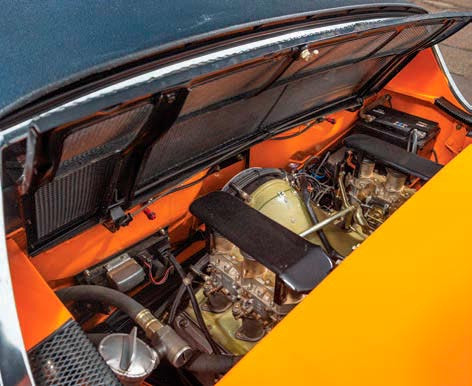
The cockpit is not as austere as one might expect of a full-on race and rally car. Schroth racing harnesses wrap the Scheel GT seats, fronted by the restored GT steering wheel and horn button. There’s black felt on all interior surfaces, as it should be. Snug. You’re surrounded by the factory-spec five-point 1.5-inch diameter tube roll cage, with removable down-tube into the passenger footwell. Lightweight door panels with leather strap-pulls and dash-pad reside close by. The Targa lid is the correct reinforced bolt-on top. Instrumentation includes a 10,000rpm tachometer, 250kph speedometer, racing fuel-level gauge, with restored heater controls and flapper boxes. The interior mirror is also a new-old-stock item. There’s also an FIA-approved six-nozzle FEV FES1800MK integrated fire safety system, plus an FEV handheld fire extinguisher.
The car runs an early aluminium crankcase (no. 960232), which is stronger than its magnesium equivalent part and houses a counterweighted, magna-fluxed, micro-polished crankshaft, running in new main bearings with reconditioned steel connecting rods and ARP fasteners. Mahle high-compression racing pistons and cylinder barrels are fitted, along with new Webcam 171e/149i camshafts, new TRW valves, early six-bolt aluminium valve covers, Aasco Motorsport springs, new rocker hardware and shafts, competition timing chains and ramps. Take a deep breath! Make no mistake, this is one hell of a comprehensive rebuild.
POWER HOUSE
True to spec, the car makes use of twin-plug heads with 40mm intake and exhaust ports. The intake manifolds are 100mm aluminium 911 R parts, a nice legacy of the 914/6’s racing forebear. Conversely, there’s a modified 911 Turbo (930) oil pump at play. Exhaust manifolds are George Narbel racing headers, finished off with a new-oldstock GT rally muffler. The early 46 IDA Weber carbs have been rebuilt, incorporating all available competition and performance enhancements, including factory-correct rain shields.
Prominent in the engine bay is the new Crawford Composites amber fibreglass cooling shroud and blue Bosch coils and single ignition box. A lightened flywheel and Centreforce clutch have also been added to the mix, as have pressure-fed Carrera chain tensioners. The heads are fastened with Raceware studs and nuts, while ancillaries include the Bosch heavy-duty starter motor and a Henry Schmidt custom billet twin-plug racing distributor.
The gearbox consists of a 901 case and 904 main gear-shaft. Internal componentry includes new axle flanges, updated axles, a Nürburgring gear set (AFKQV), 8:31 ring and pinion, side-shift conversion and improved linkages. A billet intermediate plate has also been added. Final drive is via a factory ZF limited-slip differential. There’s a proper GT front-mounted oil cooler and mounts with Wigglesworth fibreglass oil cooler shroud, too, along with a large oil filler neck with an aluminium cap and a new oil catch tank. The original 100-litre fuel tank has been restored and retained, with the correct factory racing installation modifications, plus FIA-approved Deto- Stop anti-explosion foil mesh balls, twin Bosch pumps, a swirl pot, steel lines and a closed-cell foam spacer between the tank filler neck and bonnet.
Front suspension is torsion bars and a Weltmeister adjustable anti-roll bar, with new Koni single-adjustable competition dampers. New rear springs and a 16mm rear anti-roll bar sit at the back alongside a 930 tie-rod kit and factory dog-ear trailing-arm steel reinforcements, plus Koni dual-adjustable competition shocks. There are new polyurethane bushes, strut bushes and ball joints at both ends of the car. As you’d expect, the geometry has been painstakingly dialled in and corner weighted. The original set of 7x15-inch (front) and 8x15-inch (rear) Fuchs were restored to a stunning finish by Wheel Enhancement in Lennox, California.
The braking system consists of a new 19mm master cylinder, stainless-steel brake hoses, and rebuilt (and re-plated) 911 S front calipers with stainless-steel pistons. GT calipers reside at the rear, though all the calipers clamp GT vented discs, employing Porterfield racing pads. Weight is a scant 900kg, counting towards impressive performance.
Climbing into the 914/6 GT cockpit is not as tortuous as it might appear, thanks to the long door apertures. I’m presented with an original 380mm competition steering wheel, lightweight door panels, leather thong door-pulls, wind-up windows and cloth-covered dashboard. There are internal and external ignition cut-off switches, with dashboard switches for the dual fuel pump circuit, dual ignition and back-up light. Curiously, the dashboard switchgear functions by pushing knobs in, rather than pulling them out.
This car was obviously perfectly set up for the Nürburgring and would unquestionably do the business again. Taut and solid, this mid-engined marvel is chuckable and forgiving, quickly coming back into line with lift-off understeer. In fact, this proves to be the best way to induce a return to the straight-ahead after rampant cornering manoeuvres. I like the 914/6’s user-friendliness, GT or otherwise, and admit to being surprised the works team didn’t make more use of such a brilliant Porsche. It sits very low, which helps the centre of gravity, and despite the wide tyres, it still feels nimble with instant steering response, like driving a kart. The close ratio gearbox is calibrated for sharp acceleration rather than high speeds, and I can see how an ace could drift this Porsche through bends. Our run through the countryside takes us through undulating wooded terrain and, whilst the car tracks perfectly through the turns, it’s also the brutish power delivery and sharp acceleration which impresses.
This is a great car to have fun in. It has a very different character to a 911 of similar vintage, but like all mid-engined Porsches, its sure-footed togetherness elicits a strong feeling of confidence. On a dry tarmac rally, such as Rallye Monte- Carlo Historique or Tour de Corse, this 914/6 would be one heck of a contender. Interested? If so, you’ll be pleased to learn Export 56 is currently marketing the car for sale. It’ll set you back £295,000, but considering auction house, Gooding & Company, sold a genuine 914/6 GT for $995,000 at its Scottsdale sale in 2020, this ‘great pretender’ comes as something of a bargain, especially considering how exacting Allin was in its construction — there’s no question this bright orange Porsche could reprise the 914/6 GT’s moment of glory back in 1970.
Above and below The 914 is often cited as a failure, though the model’s huge sales figures made it a big success, even though the 914/6 was hampered by unanticipated high production costs. Above Wide, boxy wheel arches are a distinguishing feature of the 914/6 GT and are often replicated on restomod builds.Above and below The 914/6 is a rare beast, leading many enthusiasts to swap a four-cylinder 914’s engine with that of an air-cooled 911.
Above Faithful replica of the winning no.1 Marathon de la Route entry is based on a genuine 914/6. Above Porsche’s works drivers were vocal in their dissatisfaction with the 914/6, citing its neutral handling as a disadvantage when compared with time behind the wheel of the contemporary 911, yet used the roadster to take all three podium places at the 1970 Marathon de la Route.


